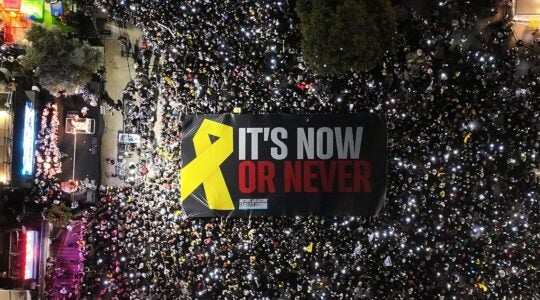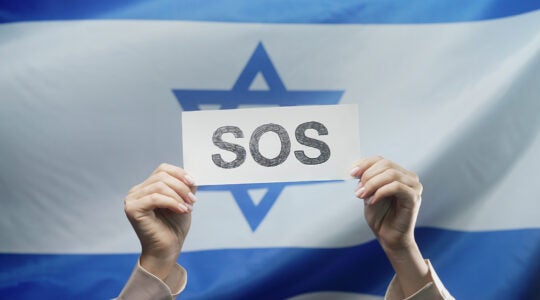WADI AL-NAAM, Israel (JTA) – In this unofficial Bedouin town of 14,000 not far from Beersheva in the Negev Desert, families live in clusters of shanties with intermittent electricity provided by generators or solar panels.
A communal structure has soft plastic walls and dirt floors, with a small pit at one end for an open fire that provides the room’s only heat. Roads in many places are demarcated only by piles of rocks.
For decades, Bedouin tribes like those living in Wadi al-Naam and similar settlements all over southern Israel have waged a battle with the Israeli government over land rights, with the government refusing to recognize the unofficial settlements or give them electricity or infrastructure and the Bedouins refusing to move.
Ismail Barfash, a local locksmith, says if he wanted to move to the nearby recognized Bedouin town of Segev Shalom, he would have long ago.
“I like the quiet here,” Barfash said. “No one comes here to ask what you’re doing. I prefer to die here and not move somewhere else.”
Last week, Israel was set to bring a major resolution to the dispute by enacting a law — years in the making and following months of Knesset debate — that would have legalized some Bedouin villages and given them infrastructure while forcing others to relocate to recognized towns, where they would be given small land plots and some cash grants.
But the plan was shelved late last week with no vote after opponents on the right and left expressed concerns. Now the government must go back to the drawing board.
Some opponents of the law and many Bedouin say the government wants to confiscate their land and profit from it, using it for industry or the military. The government says it wants to settle the claims so that it can use the lands to develop housing and infrastructure.
The law would have addressed the status of approximately 110,000 Bedouin who live in unrecognized villages in the northern Negev.
“It’s not about taking the Bedouin and making a transfer,” said Doron Almog, director of the office of Economic and Community Development of the Negev Bedouin in the Prime Minister’s Office. “It’s relocation from poverty to modernity. This will happen together with the Bedouin.”
In Lakia, one of seven Bedouin towns set up by the government about four decades ago as an experiment in transitioning the historically nomadic group to a more modern, urban lifestyle, one vexing issue is what the newly resettled nomadic Bedouin would do in their new urban digs.
“Bedouins used to plant olive trees and work the land, but that isn’t appropriate for the city,” said Nabhan El-Sana, project director for the Lakia Local Council.
Life in the Bedouin towns is not easy. According to Israel’s socioeconomic rating system, no Bedouin town scores better than a two out of 10. Residents tend to be poor, unemployment is high, infrastructure is in short supply and municipal budgets are small. Those who work usually do so outside of town in nearby Jewish villages or cities.
“The situation is very difficult,” said Talal Alkrinawi, mayor of Rahat, the largest Bedouin city in Israel. “The worst communities are the Bedouin towns. The reason is that the government didn’t invest resources to develop industry and economy in the Bedouin cities. They didn’t worry about quality of life.”
Alkrinawi says that 79 percent of Rahat residents live below the poverty line. In 2009, the unemployment rates for Rahat and Lakia were 12 percent and 19 percent, respectively, compared to 6 percent nationally. In Rahat, the average annual salary is less than $20,000, compared to more than $32,000 nationally.
A government-sponsored employment program in Rahat run out of a new community center for young people aims to put more of the city’s young adults to work. It offers employment counseling, professional certification programs and entrepreneurship coaching.
But Hasan Abu Zaid, the youth center’s director, says many challenges persist. One of the greatest is the relatively small proportion of Bedouin with college degrees. About 46 percent of Israelis aged 25 to 64 have college degrees, according to the Organization for Economic Cooperation and Development, but only 6 percent of Rahat residents do.
“The picture is not rosy,” Abu Zaid told JTA. “We believe that employment must be accompanied by business development in the town. The Bedouin population always worked. It’s not that they don’t want to work.”
Government officials say that programs like the youth center plus a final settlement to land disputes will help growth in Bedouin employment rates and quality of life. The government is developing an industrial park outside Rahat, as well as a new neighborhood in the city that will offer subsidized housing to local Bedouin.
“We need to plan things and execute them slowly,” said Ami Tesler, head of the Community Relations Department for the Bedouin in the Prime Minister’s Office. “If you understand you have a certain number of families in a certain area, you have to plan schools and roads. It’s a process.”
Many Bedouin living in the unrecognized villages do not see relocation as the answer, however. Attia Alasam, head of the Regional Council of Unrecognized Villages, says he prefers that the government instead recognize the unofficial villages, settling land disputes and providing the villages with infrastructure and basic services.
“They need to solve this with dialogue,” he told JTA. “The state says I want to do good to you. When it destroys my village, what’s good about that?”
JTA has documented Jewish history in real-time for over a century. Keep our journalism strong by joining us in supporting independent, award-winning reporting.






